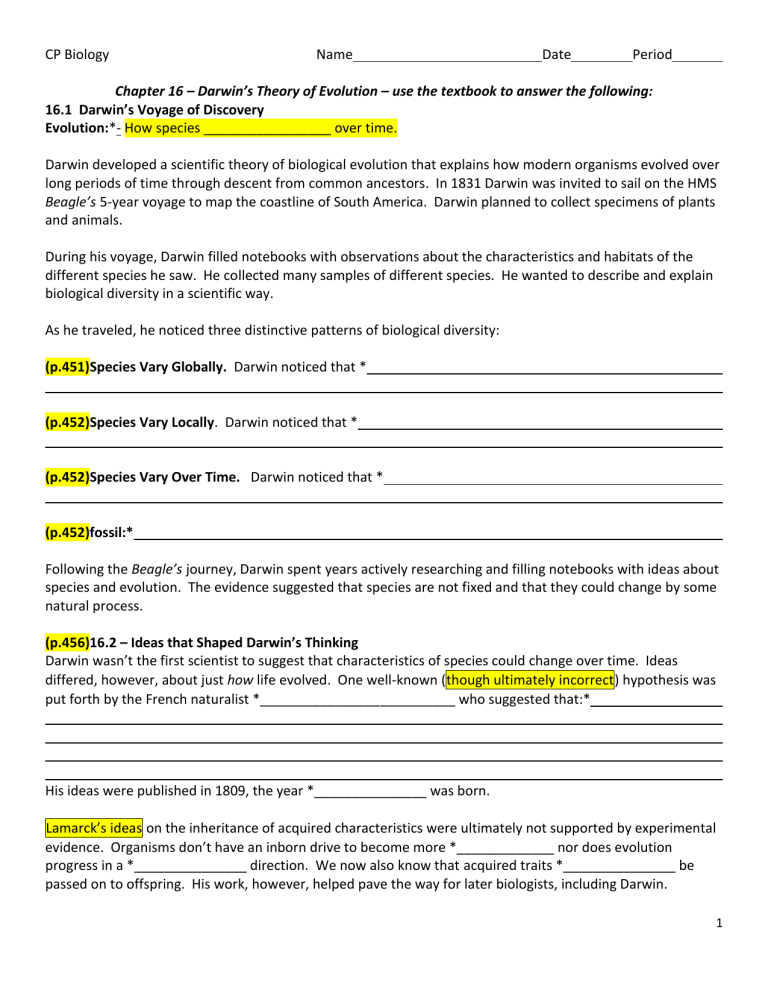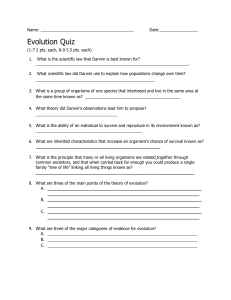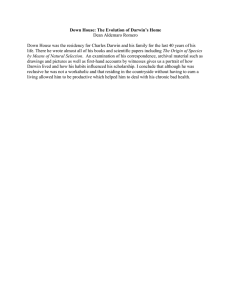
CP Biology Name Date Period Chapter 16 – Darwin’s Theory of Evolution – use the textbook to answer the following: 16.1 Darwin’s Voyage of Discovery Evolution:*- How species _________________ over time. Darwin developed a scientific theory of biological evolution that explains how modern organisms evolved over long periods of time through descent from common ancestors. In 1831 Darwin was invited to sail on the HMS Beagle’s 5-year voyage to map the coastline of South America. Darwin planned to collect specimens of plants and animals. During his voyage, Darwin filled notebooks with observations about the characteristics and habitats of the different species he saw. He collected many samples of different species. He wanted to describe and explain biological diversity in a scientific way. As he traveled, he noticed three distinctive patterns of biological diversity: (p.451)Species Vary Globally. Darwin noticed that * (p.452)Species Vary Locally. Darwin noticed that * (p.452)Species Vary Over Time. Darwin noticed that * (p.452)fossil:* Following the Beagle’s journey, Darwin spent years actively researching and filling notebooks with ideas about species and evolution. The evidence suggested that species are not fixed and that they could change by some natural process. (p.456)16.2 – Ideas that Shaped Darwin’s Thinking Darwin wasn’t the first scientist to suggest that characteristics of species could change over time. Ideas differed, however, about just how life evolved. One well-known (though ultimately incorrect) hypothesis was put forth by the French naturalist *__________________________ who suggested that:* His ideas were published in 1809, the year *_______________ was born. Lamarck’s ideas on the inheritance of acquired characteristics were ultimately not supported by experimental evidence. Organisms don’t have an inborn drive to become more *_____________ nor does evolution progress in a *_______________ direction. We now also know that acquired traits *_______________ be passed on to offspring. His work, however, helped pave the way for later biologists, including Darwin. 1 16.3 Evolution by Natural Selection (visual summary p.462) Darwin ultimately described a scientific mechanism for the change of species over time. In his book On the Origin of Species, he combined his own thoughts with ideas from other scientists of his day. *________________________________________ = more individuals are produced than can survive; members of a population must compete for food, living space and other necesseties of life. *________________________________________ = Individuals have natural variations among their heritable traits. Some variants are better suited for life in their environment than others. Any heritable characteristic that increases an organism’s ability to survive and reproduce in its environment is called an *____________________. Adaptations can be physical, physiological, or behavioral in nature. *________________________________________ = Differences in adaptations affect an individual’s fitness. *____________ describes how well an organism can survive and reproduce in its environment. Individuals with adaptations that are well suited to their environment can survive and reproduce and are said to have *_________ fitness. Individuals poorly suited to their environment either die without reproducing or leave few offspring and are said to have *_________ fitness. Survival, in evolutionary terms, means more than just staying alive – it means *______________ and passing *_______________ to the next *__________________. *________________________________________ = the mechanism for evolution; the process by which organisms with variations most suited to their local environment survive and leave more offspring. It is called “natural” selection because the *_______________, not a farmer or animal breeder, influences fitness. p. 463: Natural selection occurs in any situation in which: 1.* 2.* 3.* (p.464)Remember, the goal of natural selection isn’t to “produce perfect organisms”. Natural selection also doesn’t move in a fixed direction. If conditions change, a trait that was once beneficial may no longer be useful, and different traits may become adaptive. There is no one, perfect way of adapting to a particular environment. p. 464: According to the principle of common descent, all species – living and extinct – are descended from ancient *___________________________________. Perhaps one of the most well-known examples of species studied by Darwin during his Beagle journey was the finches of the Galapagos Islands. Scientists are still studying their populations today, in fact. 2 Read p. 496-497. Summarize the current hypothesis about how speciation occurred among Galapagos Finches. * Read page 493, “Biology & Society: Should Antibiotic Use Be Restricted? Summarize how a population of bacteria may develop bacterial resistance by natural selection. * The Peppered Moth – Industrial Melanism Go to the following website: http://www.biologycorner.com/worksheets/pepperedmoth.html and read the two-paragraph introduction. Then follow the online Instructions to try the simulation in both a Lichen (light colored) forest and a Soot (dark colored) forest. Summarize how the peppered moth illustrates yet another example of natural selection. * 3 16.4 - Evidence of Evolution Biogeography (p.465) Patterns in the *____________________________________________ tell us how modern organisms evolved from their ancestors. The Age of Earth and Fossils(p.467) Many recently discovered *_______________ form *___________ that trace the evolution of modern species from extinct *________________. Recall that the earth is about 4.5 billion years old, which is plenty of time for evolution by natural selection to have taken place. Comparing Anatomy and Embryology (p.468)Homologous Structures:* Homologous Structures are evidence of common descent. Examples: bones found in vertebrate forelimbs (p.469)Analagous Structures:* Analagous Structures are NOT evidence of common descent, rather they may indicate similar adaptations to environmental pressures. Examples: The wing of a bee and the wing of a bird (p.469)Vestigial Structures:* Vestigial structures, as a type of homologous structure which has lost its important function, are evidence of common descent. 4 Embryology (p.469) Similar patterns of *______________________ development provide further evidence that organisms have descended from a common ancestor. (p.470) Genetics and Molecular Biology - BEST EVIDENCE OF COMMON ANCESTRY Darwin knew nothing about how heredity worked; however, today some of the strongest evidence supporting evolutionary theory comes from genetics. Life’s Common Code All living cells use information coded in *__________ and *____________ to carry information from one generation to the next and to direct *_______________ _______________. This genetic code is nearly *___________ in almost all organisms, giving strong evidence that all organisms evolved from common ancestors that shared this code. Homologous Molecules In Darwin’s day, biologists could only compare structures they could see; today we know that homology is not limited to physical structures. Molecules (such as the protein *________________________, which functions in cellular respiration) and even genes can be homologous between different species. 5 Biology Name The Charles Darwin Game Charles Darwin was a naturalist and scientist from England. He grew up in the early 1800s, a time when the scientific view of the world was changing. Geologists were learning that the world was very, very old and is constantly changing. Biologists put forth the idea that life on Earth had also changed. Evolution is the process of change over time. Darwin was invited to sail around the world on a ship called the Beagle and collect plant and animal specimens as the captain and crew mapped the coast of South America. Darwin’s theory of evolution came as a result of his observations during the 5-year journey. It offers an explanation of how modern organisms evolved over millions of years and how modern organisms came from shared (common) ancestors. It also emphasizes that life is always changing. Darwin kept his ideas to himself for many years as he collected information to support his theory. Finally, in 1859 Darwin published his first book on evolution, called On the Origin of Species. Visit the following website to learn about natural selection and play the survival game. http://science.discovery.com/games-and-interactives/charles-darwin-game.htm 1. Click “Learn about Natural Selection”. Make your way through the pages as you answer the questions below. What are some of the main ideas of Darwin’s theory? Part 1. Every species What’s a species? What’s a variation? 6 Part 2. Many Click the “+” sign when prompted to breed the birds. By looking at the pictures, tell what the baby got from each parent. Part 3. If an organism is born with ___________ that help it or attract then it will likely produce more than rivals without those traits. Eventually, traits can spread through a species. 2. Play the Survival Game! Follow the directions on screen (Who Wants to Live a Million Years?). Click on “Hints” to learn more about the variations found in this population before choosing your starter population. You can click on “More Mutations” to see all of your choices. See if you can win the game. Use your life preservers if you need to. If you “fail” then play it a few more times to see if you can get any to reach 1 million years. Summarize what you learned by playing this game about how a species can change over time. What determines whether organisms survive? 3. Read “Darwin’s Bio” by clicking the link along the top menu bar. 7 Take the Quiz. What was your score? 8




